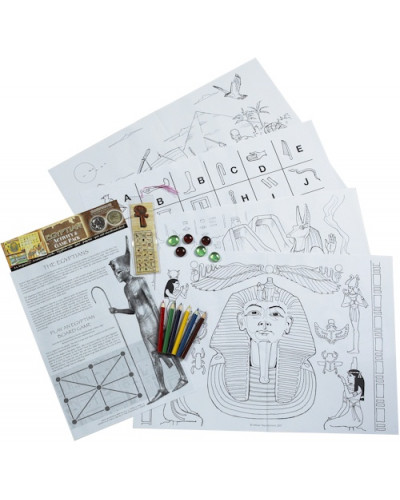Egyptian Activity & Game Pack
- Product Code: EAP
- Availability: In Stock
- Pack Qty: 1
Product Description: The Egyptian Activity & Game Pack consists of four A3 size colouring sheets, six colouring pencils and an Egyptian factsheet with board game and glass beads. Also supplied is an Egyptian papyrus bookmark and an Egyptian coin attached to the header card.
The colouring posters include a single image of Tutankhamun’s gold mask and other artifacts, a mummification scene, a River Nile scene, and a poster depicting the hieroglyphs that made up the alphabet. The factsheet and game board explain about the ancient Egyptian civilisation, how hieroglyphics were used in writing, prices and wages and a quiz. The game board on the sheet together with the provided glass beads is used to play an ancient Egyptian game. There is a colourful header card that has pictures showing how the posters could be coloured in and also has an Egyptian coin attached. On the header there is also information about Papyrus and the coin.
Information: Ancient Egypt was a civilisation in North-eastern Africa concentrated along the middle and lower reaches of the Nile River. The Nile was very important as it provided food, water for crops and boats could sail up and down it to trade. The civilisation was based on a balanced control of natural and human resources under the leadership of the pharaoh, religious leaders and court administrators. The power of the pharaohs officially ended in 31 BC, when the Roman Empire conquered Egypt and made it a province of the Empire.
The Egyptians believed in the afterlife so when the pharaoh or other wealthy people died they would be mummified. This process involved taking out the body’s organs and placing them in Canopic jars. Then the body would be washed with oils and crystals and wrapped in linen to preserve it. The body was then placed in inner and outer coffins and buried. Many pharaohs had huge stone pyramids built to protect their bodies buried deep inside them.
The ancient Egyptians believed in many gods and goddesses; each one with their own role to play in maintaining peace and harmony across the land. It was important to recognise and worship these gods and goddesses so that life could continue smoothly. Some of these gods were represented by animals. Anubis was a jackal-headed god associated with death and was the guardian of cemeteries, Horus was represented as a falcon and was the god of the sky. Bast, or Bastet, was a protective goddess who had the body of a woman and the head of a cat or lioness.
Hieroglyphs or hieroglyphics were a writing system used by the ancient Egyptians. This writing uses more than 2,000 hieroglyphic characters. Each hieroglyph represents a common object in ancient Egypt. They could represent the sound of the object or an idea associated with the object.
In ancient Egypt, kings, and sometimes others, encircled their name hieroglyphs with a design that we now call a cartouche. They believed that you had to have your name written down somewhere so you would not disappear when you died.
The vast majority of ancient Egyptians existed at subsistence level. The basic needs of a person living in a warm country like ancient Egypt are minimal: water, food, a simple shelter and some clothing. Wages were paid to a large part in grain, but other goods are also mentioned, such as vegetables, fish and cloths. Much of these were eaten or used by the workers and their families, and little surplus remained with which to acquire other necessities.
Until the middle of the first millennium BC no coined money at all was used in Egypt, or anywhere else for that matter. Exchanges were concluded using the values of services or commodities. These were often grain, but later increasingly metal rings of fixed weight. The deben was about 91 grammes of copper. During the New Kingdom this metal rarely changed hands, though it was often used as a base for evaluation and comparison.
The word paper derived from the Greek term for the ancient Egyptian writing material called papyrus. Papyrus is an early form of thick paper-like material produced from the pith of the papyrus plant, Cyperus papyrus, a wetland sedge that was once abundant in the Nile Delta of Egypt. It was produced as early as 3000 BC in Egypt, and sold to ancient Greece and Rome.
Cleopatra VII became co-ruler of Egypt with Ptolemy XIII in 51 BC, but was driven out by Julius Caesar in 48 BC. Julius Caesar restored her to the throne and she bore him a child. She accompanied him to Rome where he was assassinated 2 years later. She then returned to Egypt and met Mark Antony and bore him twins. In 32 BC the Roman Emperor Octavian declared war on her and Mark Antony. In the following year the sea battle of Actium resulted in a defeat for Cleopatra and Mark Antony and both later committed suicide. Egypt then passed into Roman hands.

